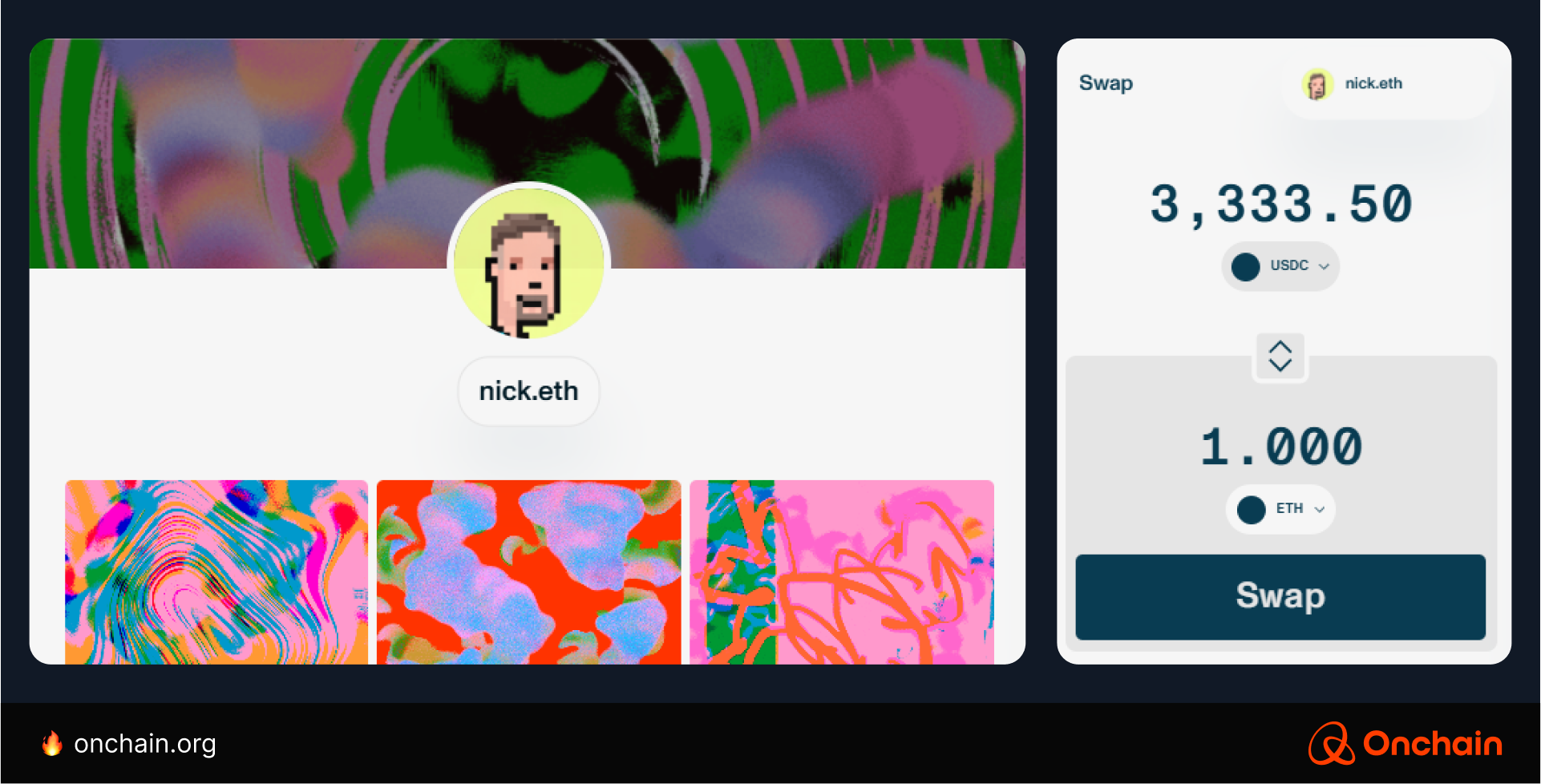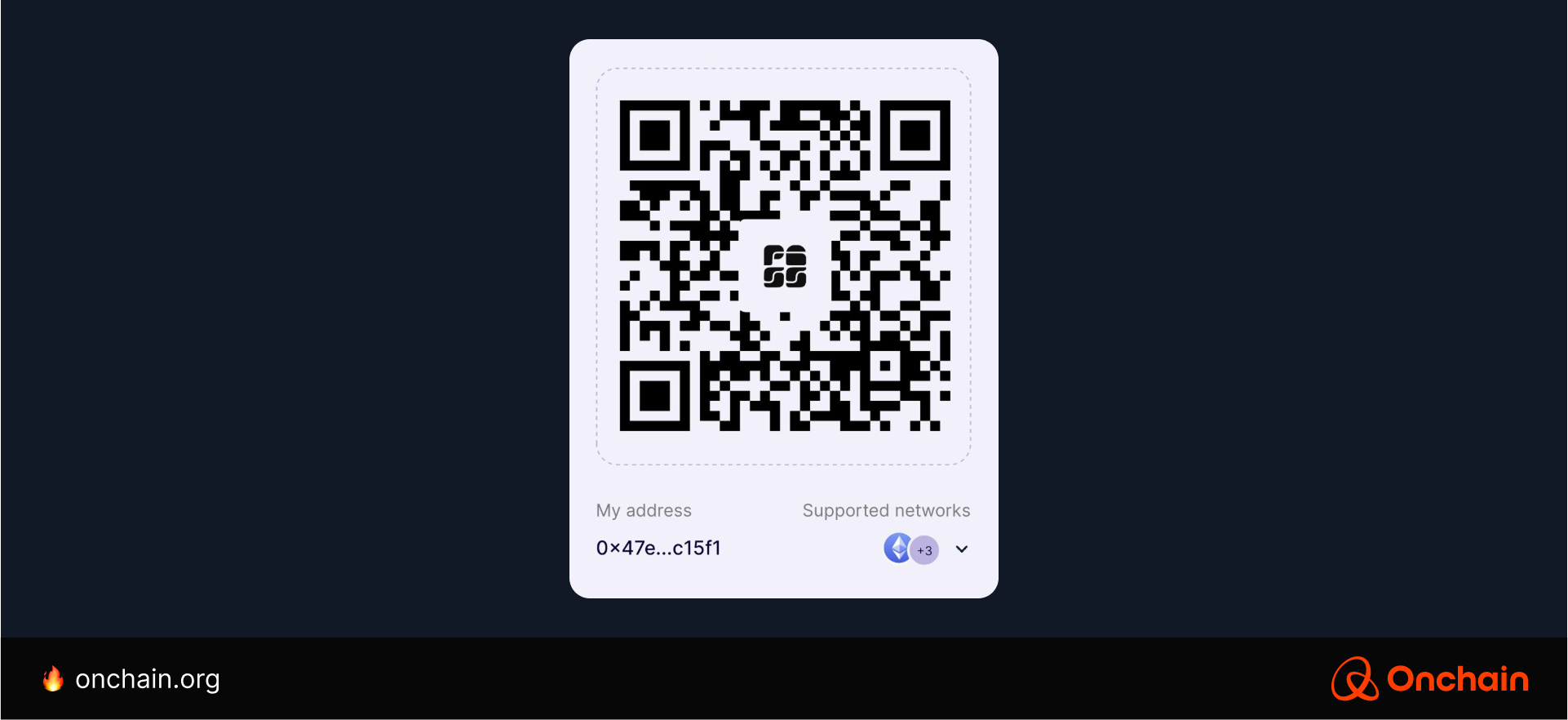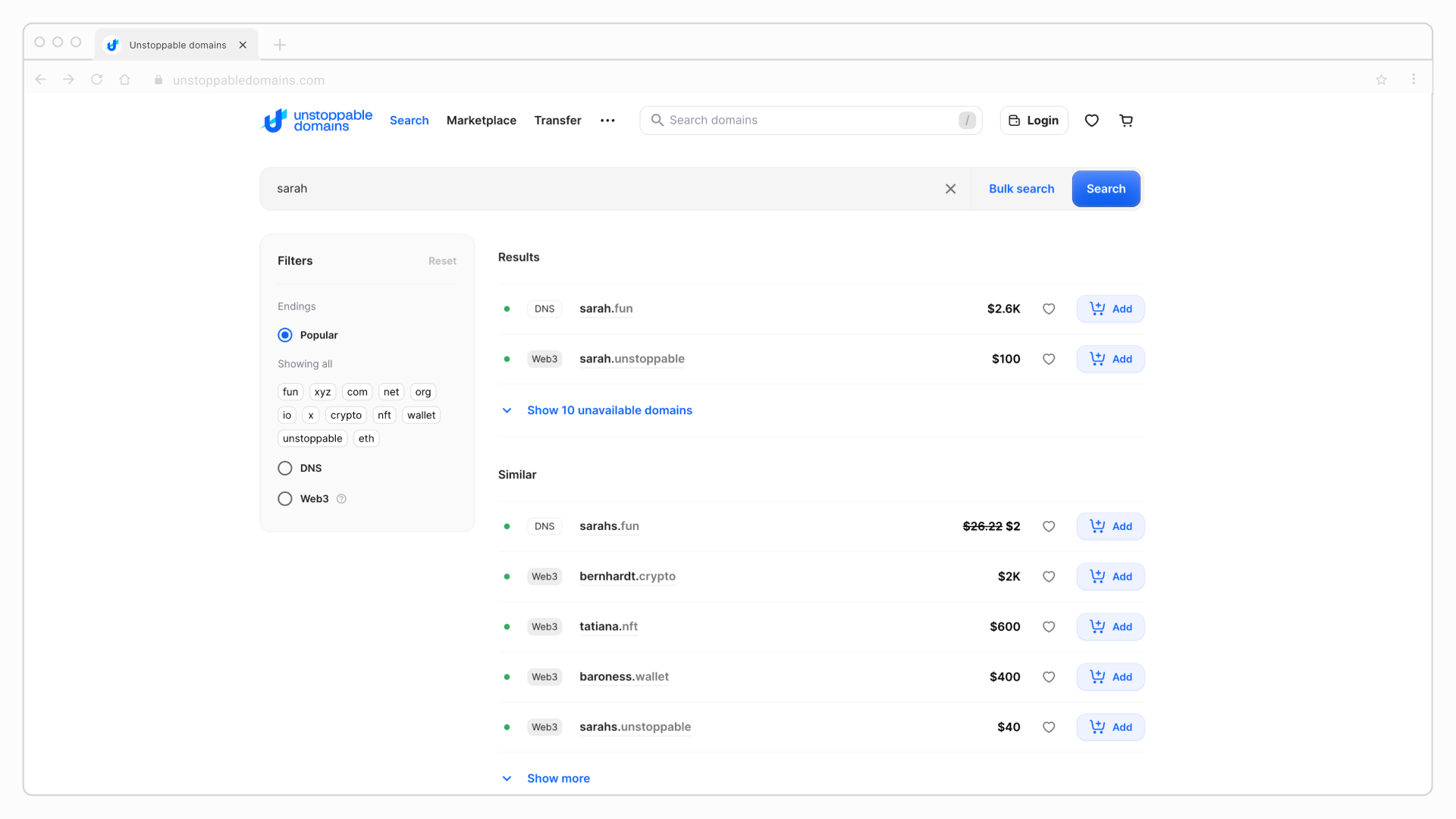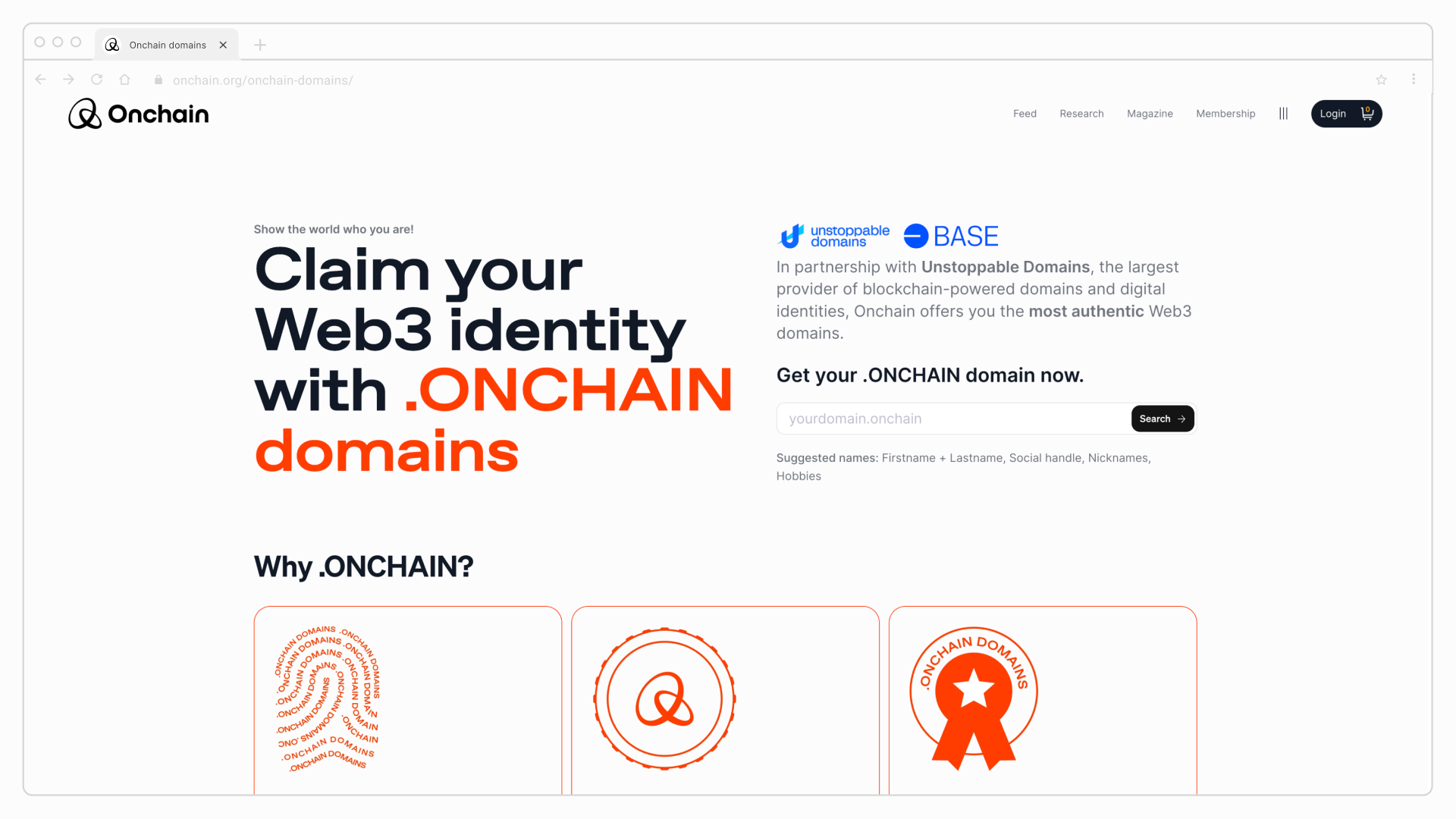Wouldn’t it be cool, if onchain web domains had “onchain” as a TLD? That’s what we thought. So, we at Onchain partnered with Unstoppable Domains and launched .ONCHAIN domains.
This happened in January ‘25. Today there are already 5000+ domain addresses with “onchain” after the dot. Sorry for the brag, but we do think it’s cool to see names like aistudio.onchain, happy.onchain, or allthedrama.onchain. Or what about success.onchain? That one’s still available at the time of writing 😃
Onchain domains aren’t just cool to have, they also have advantages over the good ‘ol (🤔) DNS domains. You’ll want to know exactly how they differ. And if you’re somewhat Web3 tech savvy, you’ll want to know how our onchain domains differ from ENS domains.
This article breaks it down for you. Centralized vs decentralized ENS domains and Onchain’s very own — and aptly named — .onchain domains.
Let’s start at the beginning.
DNS vs. onchain web domains: from Web2 to Web3
DNS stands for Domain Name System. It takes a website address like onchain.org and converts it into an Internet Protocol (IP) address like 18.239.183.26. This works better for humans because most of us find it easier to remember words rather than a numerical sequences.
DNS servers are scattered throughout the world. You could say the system is partially decentralized, however, it’s far from the robust decentralization of Web3. Web2 domains are controlled by the Internet Corporation for Assigned Names and Numbers (ICANN).
When you purchase a website domain, you essentially rent it. In plain English: you don’t really own it. You do this through an intermediary domain registration/management service like Squarespace, GoDaddy, or NameSilo.
If you forget to pay the domain renewal fee, you relinquish your ownership rights. (Don’t ask how I know. 😟)
The suffix of a website address is the top-level domain (TLD). We’re talking about the part that follows the dot, such as .com, .net, .edu, .info, and others. Onchain web domains look like standard domains with different TLDs like .crypto, .eth, and .onchain.
What are ENS domains? Ethereum’s onchain answer to DNS
The decentralized Ethereum Name Service (ENS) launched in 2017. It’s Ethereum’s answer to centralized domein management. You can register an ENS domain and use it across the Web3 ecosystem.
ENS records are secured by Ethereum and cannot be destroyed. Millions of ENS domains are controlled by smart contracts. You can link ENS domains to crypto wallets, IP addresses, the InterPlanetary File System (IPFS), and other hashed content.
A key difference between ENS and other onchain domains is that ENS is largely focused on the Ethereum ecosystem. All ENS domains use .eth as the TLD.
Other onchain domains may focus on other blockchains or be blockchain agnostic.

Onchain’s Web3 domain offering
Like ENS domains, our Onchain domains allow you to link your crypto wallet and other content directly to your .onchain TLD. Using a human-readable onchain domain can be a huge improvement from the headache-inducing experience of using a hexadecimal wallet address like 0x47e51a209f2c9f5be83fbaeb0d3675fb1fdc15f1.
If you made just one tiny typo in that string of meaningless letters and digits, the transfer fails — and your crypto is lost.
With a meaningful address that you can actually remember by heart like steve.onchain or sarah.onchain, you’ll avoid this. Website addresses are all readable; why shouldn’t all crypto addresses be as well?
These Web3 domains are compatible with over 30 popular crypto wallets and growing. Here’s an insider tip, try out Pass App when it comes out.
Instead of typing in an address, all you’ll need to do is scan the QR code address. Whether complicated, or simple, you no longer need to remember any address.

We’ll add the PassApp to the available wallets for .onchain domains when they launch.
By the way, if you are a “Steve” or “Sarah,” these two names are still available (as of March 2025):

Through a search feature, you can look for available names. Prices vary but tend to be cheaper than ENS domains. While .eth and .onchain TLDs share a lot of features and traits, they also differ substantially in some key areas.
That’s what we’ll look at next.
Onchain vs. ENS Domains: Web3 TLD showdown
Both .eth and .onchain domains provide benefits for those interested in transacting in crypto and getting immersed in the Web3 world. That’s true for crypto newbies and natives alike. Let’s give you a higher-resolution look at the similarities and differences between these two options.
.eth and .onchain similarities
When compared to legacy Web2 domains, both of these Web3 domains show that blockchain-compatible addresses are well suited for the ever-growing onchain world.
- Safe from DNS attacks: Traditional websites are vulnerable to a variety of DNS attacks that can compromise a website. Onchain domains are a secure alternative.
- Transferrable onchain domains: These Web3 domains can be bought, sold, and transferred — just like other onchain assets. In fact, these domains are technically non-fungible tokens (NFTs) and can be found on OpenSea, Magic Eden, and other NFT marketplaces.
- Web2 and Web3 interoperability: Link to crypto wallets, websites, your ID, and other data to simplify your onchain/online life.
- Human readability: Easily give merchants, clients, and customers an address to conduct onchain crypto commerce and trade. Need I say more?
- Subdomains: With only one onchain domain, you can create subdomains that can be linked to different wallets, websites, or other content. For example, if you bought the domain steve.onchain, you could create subdomains like wallet1.steve.onchain or wallet2.steve.onchain.
This allows you to organize your Web3 life, create subdomains for family members, your business or employees, and a whole lot more.
.onchain and .eth differences
While both of these Web3 TLDs will get your domain on the blockchain, there are some notable differences between them.
- Renting vs. owning: ENS domains are similar to Web2 domains and require an annual renewal fee that can vary from $5–$640 based on the character count. In contrast, .onchain domains have no renewal mechanism. Once you buy it, you own it.
- Fee structure and costs: Costs and prices vary depending on the desirability of the domain. Renewal costs should be factored in if you plan on using an ENS domain. Onchain domain owners set their own prices when reselling domains.
- Ethereum-focused vs. blockchain agnostic: Domains like .onchain support thousands of coins and tokens. ENS domains were originally focused on the Ethereum ecosystem but have expanded to support other blockchain protocols.
Onchain Web3 domain opportunities
For many, onchain domains are just a good way to simplify and secure your onchain life. For entrepreneurs and entities, Web3 domains can also provide some good business opportunities. Here are a couple worth mentioning:
- Buy, sell, and trade onchain domains: For those that accumulate sought-after domains, there are opportunities to profit. Much like NFTs and Web2 domains, you may (or may not) be able to resell them for a substantial profit. Bitcoin maximalist Michael Saylor HODLed Web2 domain voice.com and sold it for $30 million.
- Branding and marketing opportunities: With the ability to create subdomains, you can sell or give away Web3 subdomains with your company name on them. For example, Uniswap offers a free .uni.eth subdomain for every one of its mobile app users.

How to get an ONCHAIN domain
It’s super easy to claim your Web3 identity. So, don’t wait, get your desired domain name, before someone snatches it away. Go to the Onchain Domains Page to search for available onchain domain name or find answers to FAQs.
Once you find a domain you like, just add it to your cart. You’ll then be redirected to Unstoppable Domains where you can complete your purchase.
ENS domains are nice, and we love Ethereum, but Onchain thinks you should get a .onchain domain. Maybe we’re a little biased. 😜
And in case you’re wondering, yes, onchain.onchain is already taken.🙂
Claim your onchain identity now.



